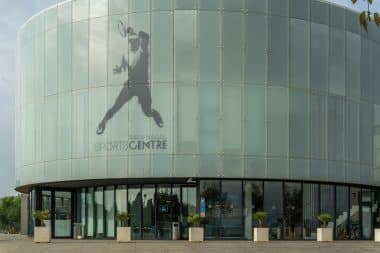If you come from the west and reach Manacor, you will see a lot of concrete along the road: large supermarkets, gas stations, pearl and furniture factories. On the other hand, the centre of Mallorca’s third largest city has a lot of charm and is full of art treasures. Visitors only love Manacor at second glance. The modern city coat of arms shows a hand encircling a heart. “Man a cor” translates as “hand on heart”. Historians, however, insist that the city’s name is derived much less poetically from a Berber tribe called “Mancur”.
Surprisingly untouristy for Mallorca
In addition to the city of Manacor in the east of Mallorca, eleven other towns belong to the municipality. The city itself is surprisingly untouristy. Connoisseurs claim that it has been able to retain its Mallorcan idiosyncrasies to this day. Hectic is not one of them. The relaxed way of life of the Manacori is well known, they say, and the afternoon siesta lasts longer than elsewhere on the island, despite the otherwise urban life. It only gets touristy where beaches await holidaymakers: in S’Illot, Porto Christo, Cales de Mallorca or Cala Murada. These are just a few of the eastern districts of Manacor. In Son Macia, beautiful villas and fincas with sea views are hidden in hills and on lush green mountain slopes.
Palma’s little sister is something to be proud of
The city centre of Manacor surprises holidaymakers with ancient defensive towers, magnificent Wilhelminian buildings, spacious pedestrian zones, secluded corners and pretty cafés, bars and bistros with tables and chairs under lemon trees. Here you can enjoy the “Pa amb Oli” – the typical Mallorcan bread with garlic mayonnaise. It is worth taking a walk around the squares of Sa Bassa and Plaça Constitució. Every morning there is a vegetable market on the Constitution Square. On Plaça Ramon Llull there is a weekly market every Monday where you can buy souvenirs. Maybe a salad server made of olive wood?
Manacor is known for its olive species. The atmosphere in the city centre may be a little more rustic than in the island’s capital Palma, but Manacor doesn’t have to hide. If you’re looking for shopping, this is the place for you, because boutiques abound. Above the hustle and bustle in the middle of the old town is the mighty, neo-Gothic church “Parròquia de la Mare de Déu dels Dolors” with beautiful colorful windows, figures of saints and a cloister. Like the other churches of Manacor, it is worth seeing. The city offers a variety of accommodations – from simple guesthouses to a luxury hotel with five stars. If you are looking for something original, you will find luxury apartments housed in old sheepfolds.
From the Stone Age settlement to defensive towers from the Middle Ages
As early as 2000 BC, people settled in Manacor. Remains of Stone Age dwellings are still there. The settlement of S’Hospitalet Vell, which archaeologists estimate to date back to 1500-1800 BC, surprises with the ruins of a square tower, a column and a huge stone slab as a ceiling. Towers also played a role in later centuries. In the Middle Ages, the mansions of noble families had to be protected against attackers: the two-storey Torre dels Enagistes (“Tower of the Jesuits”) from the 14th century, a true fortress, is now home to the “Museo de Historia de Manacor” for archaeology and ethnology. On display are exhibits from the past millennia: ceramics, sculptures, mosaics, graffiti from many eras and the skeleton of a Mallorcan cave goat, which is unfortunately extinct.
Upturn in the second half of the 19th century
Until the 19th century, the inhabitants of Manacor lived from agriculture and animal husbandry, windmills dominated the landscape. But in the second half of the century came the industrial boom. While pottery, wine and liqueur production continued to play a role, furniture production and pearl production now became an economic sector that is still of great importance today. Manacor became a rich city. This is mainly due to an imitation pearl that resembles natural pearls or cultured pearls. It was developed by a German. The son of a factory owner, Eduard Heusch from Aachen (1865-1937), opened Manacor’s first pearl factory in 1902 and called his product “Perlas Majórika”. The special feature: The Mallorca pearl is made of organic material from the sea and has a glass or stone core. Their mother-of-pearl layers are not made of mother-of-pearl, but of fish scales and shell limestone – which are specially processed into a kind of mother-of-pearl porridge. This is applied to the core in many layers and hardened several times. The colored shimmer comes from colored minerals. Jewellery experts appreciate Mallorca pearls because they are more robust than originals, but can hardly be distinguished from the real thing.
The Dragon’s Cave with classical music and illumination

If you leave Manacor behind and continue east, you will cross a scenic plain. Here, tennis player Rafael Nadal – who comes from Manacor – has built tennis courts, training centres and a school for young tennis players. The name Nadal is everywhere here, because the city is proud of him. We continue towards Porto Christo. The harbour town reminds visitors of the construction boom of the 60s, when many magnificent buildings still had to make way for parking lots. But visitors should not miss the stalactite cave Coves del Drac. It was not until 1896 that Mallorca explorer Ludwig Salvator had them researched and measured by an expedition. It not only has millions of years old, bizarrely shaped stalactites and stalagmites, but also an underground lake 180 meters long and 40 meters wide, Lago Martel. The Dragon’s Cave is a major tourist attraction. The wonderful world of the dripping stones is impressively illuminated. On the lake, a boat is picturesquely passed by the audience. In it sits a quartet that plays atmospheric classical music.


